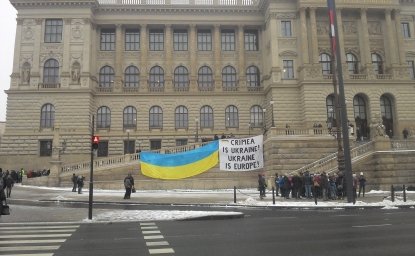Resisting Occupation: Lessons from a Natural Experiment in Carpathian Ukraine

"Schooled, nationalized populations are much more likely to resist occupation, and the propensity to resist can be measured and identified by examining the content of the initial round of mass schooling," said Keith Darden, assistant professor, Department of Political Science, Yale University at a 9 April 2007 Kennan Institute lecture. Using the Soviet occupation of two western Ukrainian provinces in 1944 as his case study, Darden suggested that the presence or absence of strongly nationalized educational systems can predict whether an insurgency will develop in a region.
The question of why certain areas resist occupation has interested researchers for a long time, Darden said. Many theories have focused on the strategy and practices of the occupying power, or the favorability of terrain for insurgent activities. Other theories stress the density of kinship, patronage, or clan networks in a particular region. In Darden's view, while all of these factors help to explain insurgencies, the most important factor in predicting whether or not an insurgency will develop is the culture and ideology of a region as developed in its school system.
During and after World War II, two western Ukrainian provinces, present-day Ivano-Frankivsk and Transcarpathia (Zakarpattia), provide nearly ideal circumstances for a "natural experiment," Darden said. He noted that nearly every factor traditionally used to explain an insurgency is the same between the two regions: the terrain in both regions is favorable to insurgent activity, peasants in both regions shared the Greek Catholic (Uniate) faith, Ukrainians made up approximately 70 percent of the population, both were ruled by the Austro-Hungarian Empire prior to the outbreak of World War I, and both experienced similar Soviet occupation strategies. Yet a large-scale insurgency developed in Stanislawow (as Ivano-Frankivsk was known at the time), while Transcarpathia had virtually no anti-Soviet activity.
Darden traced this difference in the levels of anti-Soviet insurgency to the different educational policies in the two provinces between 1867 and 1914, when they were both part of the Austro-Hungarian Empire. During this time, Ivano-Frankivsk was part of the Austrian province of Galicia, while Transcarpathia was administered by the Kingdom of Hungary. In the Austrian half of the Empire, educational reforms were put in place in regions with sizable Ukrainian populations that permitted instruction in local languages and promoted a strongly anti-Polish and anti-Russian Ukrainian nationalist narrative, Darden explained. It was at this time that the population of the region transitioned from an oral culture to mass literacy. This gave the nationalist perspective great staying power, as it was accepted by students and passed on within families, Darden stated. This national narrative was further consolidated through various civic networks that emerged, he noted, such as the Prosvita society, Ukrainian scouting organizations, private schooling known as Ridna Shkola, and eventually the Organization of Ukrainian Nationalists, which became the organizational basis for the Ukrainian Insurgent Army.
Transcarpathia, on the other hand, was ruled by Hungary, which made little effort to promote mass literacy in the region prior to World War I. The few Ukrainian peasants who were educated quickly assimilated to Hungarian culture and society, Darden stated. It was only during the inter-war period that Transcarpathia began to approach mass literacy as part of Czechoslovakia, which granted the region substantial autonomy in educational policy. The ideological content of the education most Transcarpathian peasants received was not the anti-Polish and anti-Russian Ukrainian nationalism taught in Galicia, Darden asserted. Rather, education in this region tended to have a Russophile orientation. People in Transcarpathia joined similar "civic society" groups as their counterparts in Ivano-Frankivsk—youth groups, scouting organizations, reading societies, and choral groups—but the ideological content of these groups was not a "nationalizing" one. Eventually, when the Soviet occupation came, there was strong support in Transcarpathia for a unification of the region with the USSR, he said.
"You can see the direct link between two identical provinces, which, because of an arbitrary administrative boundary within the Austro-Hungarian Empire, have very different subsequent political trajectories based on the kinds of identities that were developed in these two regions," he said. Part of Darden's research involved conducting interviews with older people in Ivano-Frankivsk and Transcarpathia, including some former partisans. These interviews highlighted the importance of Ukrainian nationalism in the decision to join an insurgency, while also underscoring the perception of cultural differences between Ukrainians in Galicia and Transcarpathia, he said.
Darden noted that this cultural dynamic persists even to this day. Contemporary voting patterns and the percentage of popular participation in the Orange Revolution indicate that Transcarpathia is still very different from Ivano-Frankivsk and the other Galician provinces of Lviv and Ternopil.
According to Darden, the wider implications of his research are that schooled and nationalized populations are more likely to resist occupation. A population's propensity to resist can be measured more accurately by analyzing the content of a region's initial schooling, not simply by analyzing ascriptive "ethnic" attributes or the geographical features of a region, he concluded.
Author

Kennan Institute
The Kennan Institute is the premier US center for advanced research on Eurasia and the oldest and largest regional program at the Woodrow Wilson International Center for Scholars. The Kennan Institute is committed to improving American understanding of Russia, Ukraine, Central Asia, the South Caucasus, and the surrounding region through research and exchange. Read more

Explore More
Browse Insights & Analysis
The OSCE is a Good Value for America

Infographic | Russia's Illegal Annexation of Crimea

Russia’s Indigenous Communities and the War in Ukraine
